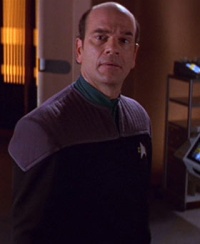Hologram
A hologram is a computer-generated image, made three-dimensional by employing the use of photons, force fields, and projected by special equipment that can usually only function on a holodeck or in a holosuite. Projected light and energy can be held within a containment field in order to give a programmed or desired appearance, as well as provide a solid surface so that matter did not pass through. Holograms can be locations, objects, animals, or people. Pre-made holograms are called holo-programs.
At the core of every piece of programming is a matrix, and holography is no different. In all matters that had to do with holograms, the heart of the program or its interface is commonly referred to as the "holo-matrix." This term is interchangeable whether one is talking about the core of a holodeck or the base of a hologram's specific programming. Typically, to design a hologram or holographic setting, one starts with a template or a psychological profile. Once the basic idea is generated, it can be modified in certain areas independently of others, for example, changing a character's sense of humor does not affect its hair color. When one is done editing, security features can be installed in order to prevent other people from tampering with the program.
Most hologram programming does not support long-term use. If a program runs continuously, it is highly possible that it can suffer from memory core fragmentation.
In order to keep a holographic program from deteriorating, one must save and exit the program periodically.
Highly advanced holoprograms, such as Emergency Medical Holograms, are considered sentient beings in their own right.
The first hologram who was able to exercise its true sentience was the EMH of the USS Voyager.
Known History
- Holograms were made by different cultures over history. The Xyrillians were the first race known to Humans to possess such technology.
- In the 23rd century, the Federation had holographic "imagers," but their resolution was less accurate than the technology that would be developed in the 24th century.
- Holographic recorders that captured motion were common by 2348.
- By the 2250s, some Starfleet vessels used early holo-communicators. While the technology fell out of use in the following decades, a more advanced version came into use again in the 2370s.
(Outside of the Federation, Klingons and Romulans were documented to occasionally use holo-communicators.)
- When the Federation banned the use of, and research into, synthetic life following the attack on Mars in 2385, the ban did not apply to holograms. The Starfleet Archive Museum made use of a holographic archivist as late as 2399.
- By the 24th century, holodecks were a standard part of Federation life.
- The first hologram to attain documented "true sentience" was a simulation of Sherlock Holmes' villain James Moriarty.
- Dr. Lewis Zimmerman created a highly advanced hologram known as the Emergency Medical Hologram, or "EMH" for short. These holograms were meant to be used for a short period of time, should medical staff need help, or if one was absent.
- The first hologram able to truly exercise its sentience was the The Doctor, the EMH of the USS Voyager.
See also:
- Holography
- Holodeck
- Holosuite
- Holographic Projector
- Hologenerator
- Mobile emitter
- Isolation suit
- Particle synthesis
- Duck blind
